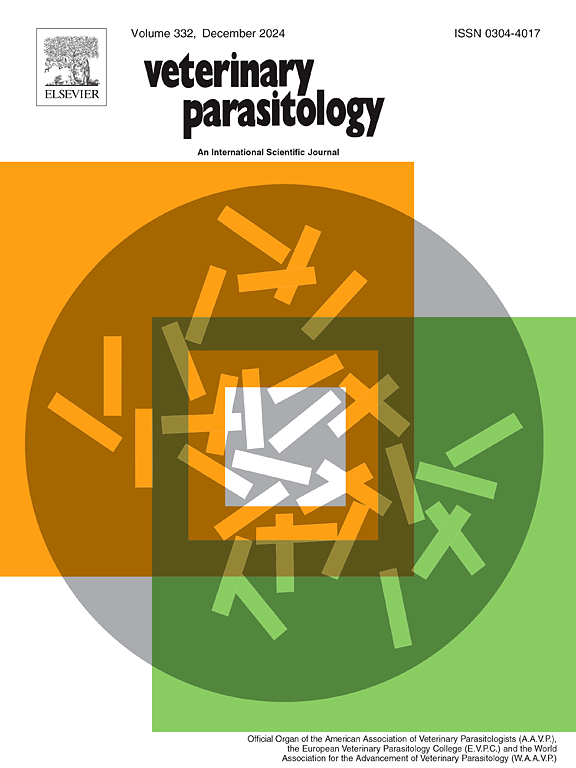天牛埃默氏菌跳颈蛋白 2 在入侵宿主肠道上皮细胞的过程中发挥着关键作用。
IF 2
2区 农林科学
Q2 PARASITOLOGY
引用次数: 0
摘要
寄生虫门的跳颈蛋白 2(RON2)在入侵宿主细胞的过程中发挥着关键作用。细胞内原生动物天牛埃默氏菌(Eimeria tenella)也有类似的保守入侵模式。然而,人们对天牛埃默氏菌 RON2 是否参与入侵宿主肠上皮细胞的过程还知之甚少。本研究分析并表达了 EtRON2 的序列。表达的EtRON2细胞外N端截短片段(403-700 aa,命名为EtRON2403-700)分子质量为38.3 kDa。兔抗 EtRON2403-700 抗体检测到孢子虫蛋白中的 EtRON2 为 151.4 kDa。免疫荧光结果显示,EtRON2 主要定位于天娥孢子虫的细胞核和顶端。qPCR 结果显示,与天娥孢子虫的其他发育阶段相比,EtRON2 在孢子化卵囊中的表达水平最高。体外侵袭抑制试验表明,在使用兔抗 rEtRON2403-700 抗体进行预处理后,孢子虫侵袭 DF-1 细胞的能力明显受到抑制。通过 RNA 干扰(RNAi)沉默 EtRON2 基因可明显抑制 EtRON2 的表达,并显著减少孢子虫对 DF-1 细胞的侵染。体内实验表明,通过泄殖腔接种感染了EtRON2基因沉默的孢子虫后,雏鸡体内的寄生虫负荷和卵囊产量均显著减少。重组EtRON2403-700(rEtRON2403-700)通过诱导体液免疫、上调IFN-γ和CD8+ T淋巴细胞,使雏鸡有效抵抗天牛埃希氏菌感染。此外,雏鸡的相对增重率提高,盲肠病变评分降低,在天牛感染期间卵囊产量减少。H&E染色显示,使用rEtRON2403-700免疫的雏鸡盲肠组织的组织病理学变化相对较轻。总之,本研究结果表明,EtRON2在天牛埃希氏菌侵入宿主肠道上皮细胞的过程中起着关键作用,并为预防天牛埃希氏菌感染的疫苗提供了潜在靶标。本文章由计算机程序翻译,如有差异,请以英文原文为准。
Eimeria tenella rhoptry neck protein 2 plays a key role in the process of invading the host intestinal epithelium
The Apicomplexa parasitic phylum rhoptry neck protein 2 (RON2) plays a key role in the process of invading host cells. Eimeria tenella, an intracellular protozoan shares a similar conserved invasion pattern. However, whether E. tenella RON2 participates in the process of invading the host intestinal epithelium is poorly understood. In this study, the sequence of EtRON2 was analyzed and expressed. The expression of the truncated extracellular N-terminal fragment of EtRON2 (403–700 aa, designated EtRON2403–700) with a molecular mass of 38.3 kDa. EtRON2 in the sporozoite protein was detected at 151.4 kDa by rabbit anti-rEtRON2403–700 antibody. Immunofluorescence results showed that EtRON2 was mainly localized to the nucleus and apex of the E. tenella sporozoite. qPCR results showed that the highest expression level of EtRON2 was detected in sporulated oocysts compared with other developmental stages of E. tenella. In vitro invasion inhibition assays showed that the capacity of sporozoites to invade DF-1 cells was significantly inhibited after pretreatment with the rabbit anti-rEtRON2403–700 antibody. Silencing the EtRON2 gene by RNA interference (RNAi) significantly inhibited EtRON2 expression and significantly reduced the invasion of DF-1 cells by sporozoites. In vivo experiments revealed a significant decrease parasite burden and oocyst outputs in chicks after infection with EtRON2 gene-silenced sporozoites by cloacal inoculation. Recombinant EtRON2403–700 (rEtRON2403–700) immunizes chicks effectively against E. tenella infection by inducing humoral immunity and upregulating IFN-γ and CD8+ T lymphocytes. Furthermore, chicks exhibited increased relative weight gain rates, lower cecum lesion scores, and reduced oocyst outputs during the E. tenella challenge. H&E staining showed that the cecum tissue of chicks immunized with rEtRON2403–700 showed relatively mild histopathological changes. In conclusion, the results of this study demonstrated that EtRON2 plays a key role in E. tenella invasion of the host intestinal epithelium and provides a potential target for vaccines against E. tenella infection.
求助全文
通过发布文献求助,成功后即可免费获取论文全文。
去求助
来源期刊

Veterinary parasitology
农林科学-寄生虫学
CiteScore
5.30
自引率
7.70%
发文量
126
审稿时长
36 days
期刊介绍:
The journal Veterinary Parasitology has an open access mirror journal,Veterinary Parasitology: X, sharing the same aims and scope, editorial team, submission system and rigorous peer review.
This journal is concerned with those aspects of helminthology, protozoology and entomology which are of interest to animal health investigators, veterinary practitioners and others with a special interest in parasitology. Papers of the highest quality dealing with all aspects of disease prevention, pathology, treatment, epidemiology, and control of parasites in all domesticated animals, fall within the scope of the journal. Papers of geographically limited (local) interest which are not of interest to an international audience will not be accepted. Authors who submit papers based on local data will need to indicate why their paper is relevant to a broader readership.
Parasitological studies on laboratory animals fall within the scope of the journal only if they provide a reasonably close model of a disease of domestic animals. Additionally the journal will consider papers relating to wildlife species where they may act as disease reservoirs to domestic animals, or as a zoonotic reservoir. Case studies considered to be unique or of specific interest to the journal, will also be considered on occasions at the Editors'' discretion. Papers dealing exclusively with the taxonomy of parasites do not fall within the scope of the journal.
 求助内容:
求助内容: 应助结果提醒方式:
应助结果提醒方式:


